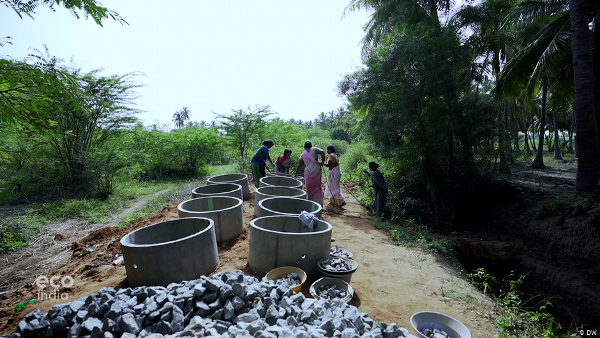NEW DELHI: With nearly half of India reeling under drought and fresh water a dangerously scarce resource, citizens in many parts of the country have taken it upon themselves to correct the bleak situation.
In Vellore, one of the 24 drought-hit districts in Tamil Nadu, women have revived the seasonal Naganadhi river — the primary source of water for the region some decades ago — after it had been lifeless for 15 years. As a result, while much of the country has gone dry, people in many villages there have sufficient water to drink and irrigate their paddy fields.
Miles away, in the hills of northern India, water conservation techniques are gaining momentum. Hundreds of villagers from Pauri Garhwal in Uttarakhand, egged on by children, are constructing reservoirs of various sizes. Many are signing conservation pledges to save rainwater this monsoon.
These states serve as an example of how India desperately needs larger engagement of local communities to protect water resources. In Vellore, it took up to 20,000 women four years to build 3,500 recharge wells and several boulder checks (using pebbles to slow down rainwater flow) to get Naganadhi to flow again in 2018. Through recharge wells, rainwater can be routed into shallow aquifers which enhance groundwater levels.
“A river flows above the surface only after the groundwater has been replenished. Therefore, reviving a river isn’t just about its flow, but getting enough water to seep into the ground. In other words, letting rainwater infiltrate the soil by slowing it down.
Once it rains this year, the river will be in full spate,” said Chandrasekaran Kuppan, director of Naganadhi Rejuvenation Project, an Art of Living Foundation (AOL) initiative. The programme is assisted by the Centre and was started in 2014.
In the last decade, much of Vellore’s agricultural labour migrated to the city as water bodies dried up, leaving nothing for irrigation. Most of those who left were men seeking contract work, leaving the womenfolk behind with little to do. But their lives changed when some AOL volunteers reached the district and suggested they revive the river. Such projects had already registered success in Karnataka where Vedavathi and Kumudavathi rivers were brought to life.
A team was employed to mark the original trail of the river using satellite mapping and then an action plan was created based on the area’s geology, geomorphology and land cover, catchment area and rainfall data. The river restoration project had government approval so women were registered as Mahatma Gandhi National Rural Employment Guarantee Act (MGNREGA) workers, which ensured them daily earnings.
Nathiya, 32, among the first batch of women roped in for the project, said that agriculture again became feasible in her village of Salamanatham in Kaniyambadi block after they built 36 recharge wells. A recharge well about 20ft deep, 15ft long and 6ft wide takes at least 23 days and 10 workers to build.
“I can now grow water-intensive paddy in my land, something I could not have imagined couple of years ago. I can grow crops as well and earn Rs 224 a day if I sign up as a MGNREGA worker,” said Nathiya. Vellore collector S A Raman said the results encouraged them to expand it to other areas.
Meanwhile, in Uttarakhand, where the hills are facing an acute water crisis, people are now signing “water conservation pledges” to save at least 1,000 litres of rainwater per person during monsoon.
Deepa Rawat, 13, from Pauri Garhwal and her classmates are building reservoirs after school to conserve rainwater. Government schools are also instructing each student to dig reservoirs that are at least 2 ft deep.
“A mass movement to conserve water is the need of the hour in Himalayan villages where natural water bodies are drying up, further driving migration,” said Surender Singh Rawat, block pramukh, Pokhra.
Source:ToI
Image Courtesy:Dw
You may also like
-
Trade Connect E-platform For Exports Is Single Window, Fast, Accessible And Transformational: Shri Piyush Goyal
-
Five Successful Years of Pradhan Mantri Kisan Maandhan Yojana (PM-KMY)
-
Global Study by Leading Experts : Swachh Bharat Mission Drives Significant Reductions in Infant Mortality Rates in India
-
India Graphene Engineering and Innovation Centre (IGEIC) Under the Vision of Viksit Bharat@2047 Launched
-
Government Launches Vishvasya-Blockchain Technology Stack
